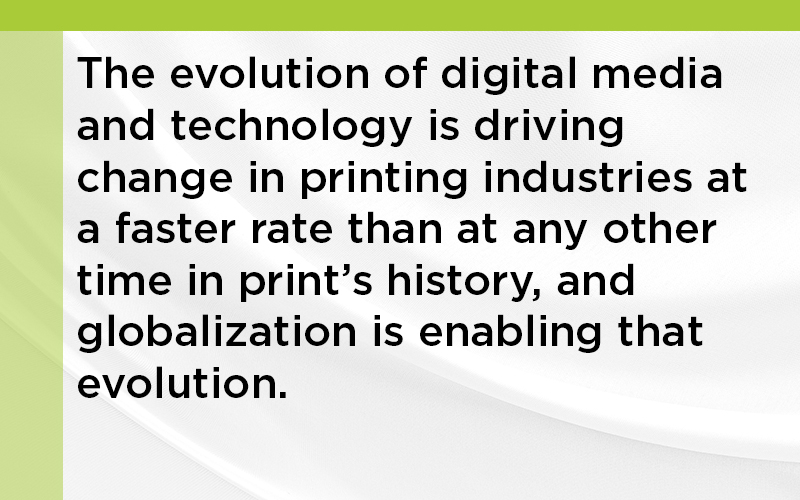
by: Kris Bovay, BIA Board of Directors President
In Thomas Friedman’s 2005 book, “The World is Flat,” he proposes that companies willing to change and accept change are more likely to do things, than have things done to them. Most business owners want the control of doing things.
The evolution of digital media and technology is driving change in printing industries at a faster rate than at any other time in print’s history, and globalization is enabling that evolution.
As part of the printing industry, binding and finishing companies need to look ahead to how their clients (printers) are doing business and what they need to do to keep pace with those changes. Print used to be part of the big three in communications (television, radio and print advertising represented about $294 billion); now print is a much smaller “piece of the pie”, splitting those advertising dollars with the other new digital entrants (such as the Internet, social networking, mobile media, email marketing and e-ink/e-paper and tablets to name a few).
While many printing companies are changing their business models to adapt to the changing landscape, they have the advantage of direct contact with their end clients. For bindery and finishing companies, the clients are typically printers. The challenge becomes adapting their bindery and finishing businesses without competing with their own customer base.
In large-market environments, such as the Northeastern United States, bindery companies have focused on diversification as their key growth strategy. However, many binderies and finishers operate in smaller (and shrinking) print markets. Their focus needs to be on developing stronger relationships with their clients and adapting to a fast-changing environment.
The first step in developing that relationship is to understand more about what is driving the printers’ business and how printers are handling those driving forces. Then it is important to know if printers are developing digital services and building cross-media solutions and, if so, what are their strengths and weaknesses? Can the bindery or finisher deliver new and/or additional support on the weakness side? Are there clear differences between what the binder or finisher offers and what the competition can provide? Make sure to have conversations with customers and develop strong strategic alliances and partnerships that help both the binder, and the customers, not only survive but thrive.
As Daniel Dejan from SAPPI Fine Papers recently said at a British Columbia Printing Industry Association meeting: “The water is rising but not all boats will float” (that is, some print industry segments will not rise to the level of sales they once enjoyed). The binding and finishing industry needs to focus on innovating, diversifying and developing unique solutions that are continually improving and keeping pace with technology and customer needs.
How can binderies and finishers grow in an increasingly fragmented marketplace? By learning to partner much more closely with printers in selling and providing cross-media benefits. Many companies have built long lasting competitive advantages by taking offense actions and by changing – be one of those companies.
Note: Loose leaf companies have an advantage in this changing environment – they have direct access to end user accounts and typically know their customers’ needs and wants really well. For loose leaf businesses, new opportunities for growth are more likely to come from focusing on environmental materials and in diversifying their products and services.

